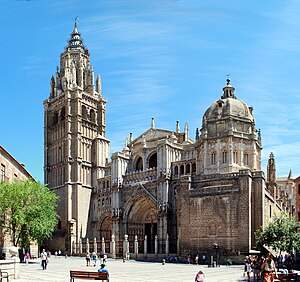Toledo Cathedral
| Toledo Cathedral | |
|---|---|
| Primate Cathedral of Saint Mary of Toledo | |
| Spanish: Catedral Primada Santa María de Toledo | |
 |
|
| 39°51′25.5″N 4°01′26″W / 39.857083°N 4.02389°WCoordinates: 39°51′25.5″N 4°01′26″W / 39.857083°N 4.02389°W | |
| Location | Toledo |
| Country | Spain |
| Denomination | Roman Catholic |
| Website | www |
| History | |
| Consecrated | 587 |
| Architecture | |
| Status | Cathedral |
| Functional status | Active |
| Architect(s) | Master Martín Petrus Petri |
| Style | High Gothic |
| Groundbreaking | 1227 |
| Completed | 1493 |
| Specifications | |
| Length | 120 metres (390 ft) |
| Width | 59 metres (194 ft) |
| Nave width | 18 metres (59 ft) |
| Height | 44.5 metres (146 ft) |
| Administration | |
| Archdiocese | Toledo |
| Clergy | |
| Archbishop | Braulio Rodríguez Plaza |
| Dean | D. Juan Sánchez Rodríguez (Dean of the Chapter) |
| Laity | |
| Organist(s) | Félix González-Mohíno Bartolomé |
The Primate Cathedral of Saint Mary of Toledo (Spanish: Catedral Primada Santa María de Toledo) is a Roman Catholic cathedral in Toledo, Spain. It is the seat of the Metropolitan Archdiocese of Toledo.
The cathedral of Toledo is one of the three 13th-century High Gothic cathedrals in Spain and is considered, in the opinion of some authorities, to be the magnum opus of the Gothic style in Spain. It was begun in 1226 under the rule of Ferdinand III and the last Gothic contributions were made in the 15th century when, in 1493, the vaults of the central nave were finished during the time of the Catholic Monarchs. It was modeled after the Bourges Cathedral, although its five naves plan is a consequence of the constructors' intention to cover all of the sacred space of the former city mosque with the cathedral, and of the former sahn with the cloister. It also combines some characteristics of the Mudéjar style, mainly in the cloister, with the presence of multifoiled arches in the triforium. The spectacular incorporation of light and the structural achievements of the ambulatory vaults are some of its more remarkable aspects. It is built with white limestone from the quarries of Olihuelas, near Toledo.
It is popularly known as Dives Toletana (meaning The Rich Toledan in Latin).
For many years, an unwritten popular tradition has held that there was originally a church from the era of the first Archbishop Eugene (Saint Eugene of Toledo) located in the same place as the present cathedral. This church was consecrated for a second time in the year 587, after having undergone some alterations, as testified by a 16th-century inscription preserved in the cloister which states:
In the name of the Lord the Church of Saint Mary was consecrated as Catholic, the first day of the ides of April, in the joyful first year of the reign of our most glorious king Flavius Reccared, Era 625 [13 of April of 587].
...
Wikipedia

